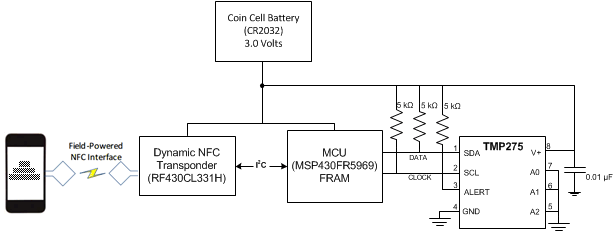ZHCSA58F June 2006 – May 2018 TMP275
PRODUCTION DATA.
- 1 特性
- 2 应用
- 3 说明
- 4 修订历史记录
- 5 Pin Configuration and Functions
- 6 Specifications
-
7 Detailed Description
- 7.1 Overview
- 7.2 Functional Block Diagram
- 7.3 Feature Description
- 7.4 Device Functional Modes
- 7.5 Programming
- 8 Application and Implementation
- 9 Power Supply Recommendations
- 10Layout
- 11器件和文档支持
- 12机械、封装和可订购信息
8.2.3 Temperature Data Logger for Cold Chain Management Applications
Cold chain management includes all of the means used to ensure a constant temperature for a product that is not heat stable from the time it is manufactured or farmed until the time it is used. This includes industries such as food, retail, medical, and pharmaceutical. Figure 19 implements a cold chain monitoring system that measures temperature, then logs the sensor data to nonvolatile (FRAM) memory in the MCU. Figure 19 uses a Near Field Communication (NFC) interface for wireless communication and is powered from a CR2032 coin cell battery with a focus on low power to maximize the battery lifetime.
The microcontroller communicates with all of the sensor devices through an I2C-compatible interface. The MCU also communicates with the NFC transponder through this interface. An NFC enabled smartphone can be used to send configuration to the application board. For a detailed design procedure and requirements of this application, see Ultralow Power Multi-Sensor Data Logger with NFC Interface Reference Design (TIDU821).
 Figure 19. Temperature Data Logger
Figure 19. Temperature Data Logger